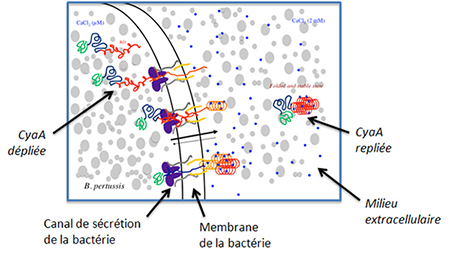Biomolecules (proteins, DNA, sugars, etc.) are often studied in purified solutions, where they have as much space to stretch out in as they might want. But in an organism, where thousands of molecules exist side by side and get in each other’s way, conditions are very different. Scientists from the Institut Pasteur in Paris have looked at how molecular crowding affects proteins, using a protein derived from the CyaA toxin produced by Bordetella pertussis, the bacteria responsible for whooping cough, as their model.

The elongated form of the unfolded state is favorable to the secretion of the protein (CyaA) through the bacterium secretion canal. The molecular congestion, represented with the grey objects, helps to maintain the protein unfolded in the bacterium (with a low calcium concentration), and to force its fold in the extracellular milieu (with high calcium concentration).
With the aid of spectroscopic methods, including SRCD on the DISCO beamline at SOLEIL, they showed that crowding could have completely opposite effects depending on whether calcium was present or absent, but always in accordance with the life and functions of the toxin. In the absence of calcium, like inside the bacteria, the toxin occurs in unfolded form: an extended configuration that is ideal for passing through the narrow membrane channels in the bacteria. In the pulmonary tract, on the other hand, the high concentration of calcium causes the secreted toxin to fold; it is then impossible for it to go back through the narrow channels. In this context, crowding helps the protein to fold up and stabilise its three-dimensional structure, which it needs to carry out its virulent attack on our cells. Remarkably, in both cases, the support of crowds is essential for the toxin. Next, the team of scientists wants to describe the characteristics of the movement of biological molecules in the crowded environments of viruses, human cells, and bacterial cells. This can be compared to the difference between a commuter moving around in an underground railway system during off-peak times compared to rush hour.
